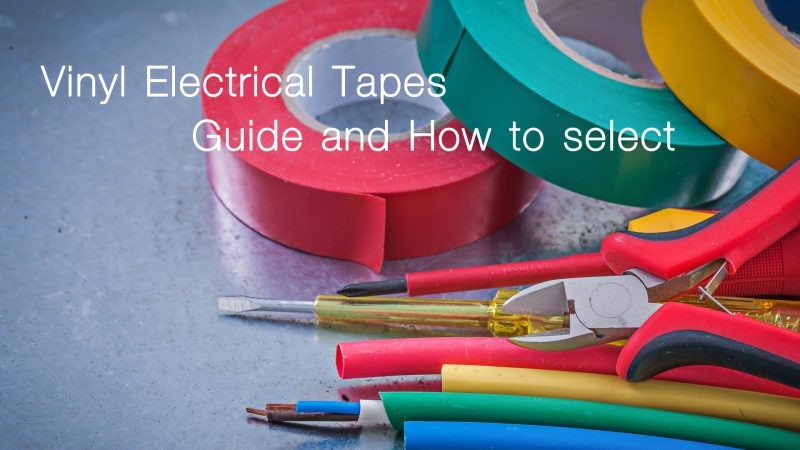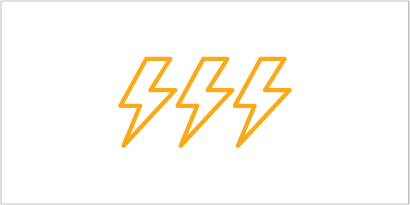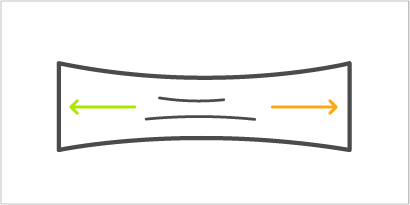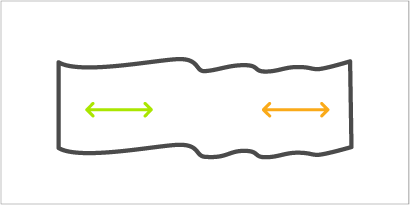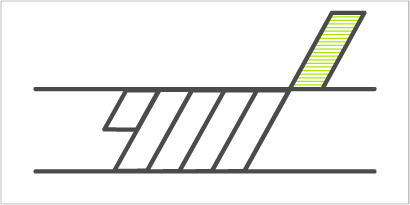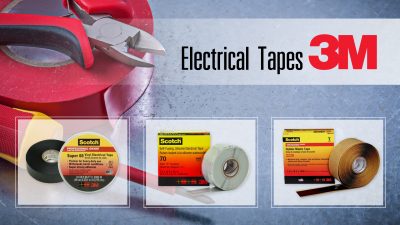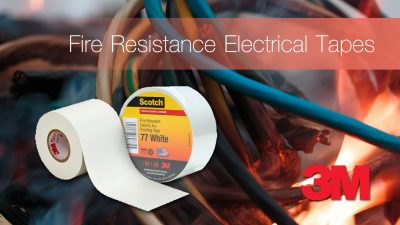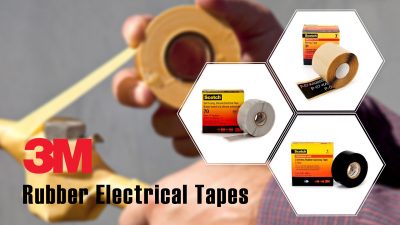Chapter 2
This article is part of ‘The Guide to Electrical Tape’

Vinyl electrical tapes are the most commonly available tapes that are resistant to abrasion and puncture as well as chemical and hash fluid. They are often used for Jacketing and Mechanical Protection of the cables. There are 6 factors that you should consider when choosing the vinyl tapes and we discussed them in details in this article.
If you would like to know more about electrical tapes, please visit our electrical tapes section.
Dielectric Strength
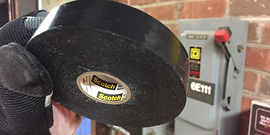
The great insulator.
An electrician will never use common duct tape as a primary insulator in an electrical installation. Electrical tapes are made with special electrical grade adhesives which don’t contribute to corrosion. The tapes are typically IEC, CSA or UL 510 listed for a voltage rating of 600V, but can go higher with thicker tapes or more layer wraps. Dielectric strength is measured in voltage per thickness. Dielectric withstand is measured in voltage. This is the point beyond which a single layer of tape may show electrical failure.
- For low voltage applications (<600V), vinyl tape is often the ‘go to’ solution for primary insulation, complex wrapping, abrasion and puncture resistance.
- For medium voltage applications; rubber, mastic, and molded devices can be used to create the electrical connection insulation.
- Even when these medium voltage tapes are used for splicing, vinyl electrical tape should be used as outer jacketing. Its tough backing creates a shell and provides excellent reistance to punctures, abrasion and corrosive contaminants.
Elongation
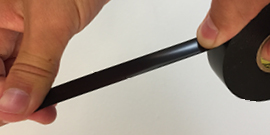
The vinyl stretch.
The capacity for a vinyl tape to stretch is one of the biggest factors in its ability to help protect and seal the installation. Good stretch equals tensile strength. That means pliability and good conformance while making a smooth, uniform and professional wrap.
- A premium vinyl tape stretches to more than twice its original length — up to 250%—before breaking.
- The UL minimum requirement for tape stretch is 150%.
- Premium vinyl tape goes to great lengths to conform, seal, and resist contaminant ingress.
- And because they stretch so well, they are less likely to break during application which saves time, materials and frustration on the job.
Elasticity
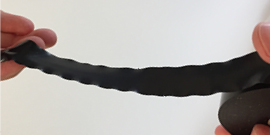
Return to sender.
Elasticity is the ability of a material to resume its normal shape after being stretched. The elastic recovery of a vinyl tape describes its ability to efficiently ‘snap back’ to its original length. A tape with excellent elasticity will continue to contract after it’s applied. This is essential to help seal connections from external contaminants. This recovery of the tape provides a better tightening of the tape wraps, forming a seal to resist alkalis, acids and moisture.
- Premium vinyl tapes have higher elasticity and will stretch and conform better on your connections.
- Because of this improved recovery, these tapes provide a tightening of the tape wraps, forming a seal to better resist alkalis, acids and moisture.
- And since they can be stretched and re-stretched multiple times without deforming, during installation you have more time and flexibility to get the job done right without wasting a roll of tape.
Temperature

Can your tape take the heat and beat the cold?
Not all tapes are made to stick in extreme temperatures. Working in cold environments, whether outside braving elements or inside a refrigeration unit, you’ll need a vinyl electrical tape with adhesive that won’t ‘freeze up’ during application. In extreme heat your tape needs a high temperature rating to help prevent peel and material deterioration, both of which compromise dielectric insulation. When evaluating vinyl tapes, the low temperature rating typically provides the lowest installation temperature. The high temperature rating indicates the highest continuous operating temperature of the tape.
- A premium grade vinyl tape will perform in a wide range of temperatures from -18ºC (0ºF) to 105ºC (220ºF).
- Only premium vinyl tapes are designed to apply and adhere in sub-freezing conditions. Most general purpose tapes will struggle to adhere to cold surfaces.
- In very hot climates, an economy tape will move and ‘slime’ the adhesive — something to consider if you’re using it for cable bundling and don’t want to scrape off goo.
- If jacketing over a mastic tape splice in a harsh environment, you’d select a premium vinyl to contain oozing.
Adhesion
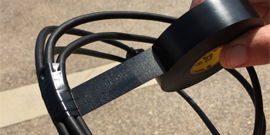
Sticky factors.
Flagging and tape curl are caused by a number of factors, including adhesive degradation and improper installation. Industrial contaminants and heat can play a factor. Tape can unwind, opening a path for corrosion. Higher grade raw materials are used in the production of premium vinyl electrical tape. Adhesion to steel is part of the ASTM D1000 physical property test for film pressure sensitive adhesive (PSA) tape. It tests how much force is required to pull the tape from a steel surface.
- When your tape has to be long lasting, the adhesion matters.
- General purpose tapes for temporary holding tend to have lower adhesion-to-steel ratings.
- Premium vinyl tapes with higher adhesion ratings will stick better to some plastics, PVC, copper, and aluminum.
- They also have more stable adhesion properties over a range of temperatures which means they should stick when you need it and where you need it.
Thickness
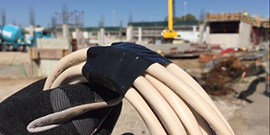
Sword and shield.
Electrical insulation can be achieved with tape as thin as paper but to create a shell to help protect from puncture; you need to layer on the vinyl−More specifically: polyvinyl chloride, (PVC). This phenomenal plastic, invented in 1913, is used today in everything from plumbing pipes to credit cards. Early efforts to make a polyvinyl film were stymied by the plasticizer used, which degraded the adhesive. In 1946, 3M researchers created a solution and Scotch® Vinyl Electrical Tape 33 was introduced to the market.
- Vinyl electrical tapes are often 5 to 7 mil. thick (7 mil is most common in the U.S.).
- The thinner general purpose tapes are often used for bundling and harnessing cables.
- Thicker premium vinyl electrical tapes are typically used as primary low voltage insulation.
- Even thicker 8.5 and 10 mil heavy-duty vinyl electrical tapes will provide extra padding as well as excellent protection in rough environments where your cables and splices are prone to abrasion and punctures.
- Thickness also plays a part in dielectric strength which increases with each successive wrapped layer. Thicker layers provide increased UV protection for outdoor applications.

The case for a jacket
While PVC-backed ‘vinyl’ tapes are the primary insulator in low voltage situations; they are also highly regarded to replace and reinforce cable jackets in low, medium and high voltage applications. Here are many ways vinyl tape helps protect.

Example of choosing Vinyl tape with 3M
You have a wide array of choices. This easy to read chart will give you performance ratings in a glance.
| Vinyl Electrical Tapes |
Scotch® Super 33+™ Professional Grade Vinyl Electrical Tape |
Scotch® Heavy Duty Grade Vinyl Electrical Tape Super 88 |
Scotch® Professional Grade Color Coding Vinyl Electrical Tape 35 |
Scotch® Extra Heavy Duty Grade Vinyl Electrical Tape 22 |
3M™ Temflex™ General Use Grade Vinyl Electrical Tape 1700 |
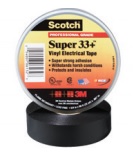 |
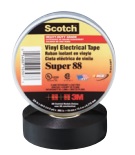 |
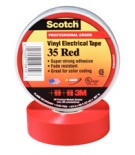 |
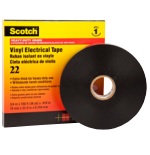 |
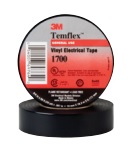 |
|
| Breaking Strength (22°C) | 15 lb/in | 20 lb/in | 17 lb/in | 20 lb/in | 17 lb/in |
| Elongation (22°C) | 250% | 250% | 225% | 200% | 200% |
| Temperature Rating | -18°C – 105°C | -18°C – 105°C | 0°C – 105°C | -10 °C – 80°C | 0°C – 80°C |
| Sticking Power (Adhesion to Steel at 22°C) | 28 oz/in | 25 oz/in | 20 oz/in | 20 oz/in | 24 oz/in |
| Thickness | 7.0 mil | 8.5 mil | 7.0 mil | 10.0 mil | 70. mil |
| Color |  |
 |
 |
 |
 |

